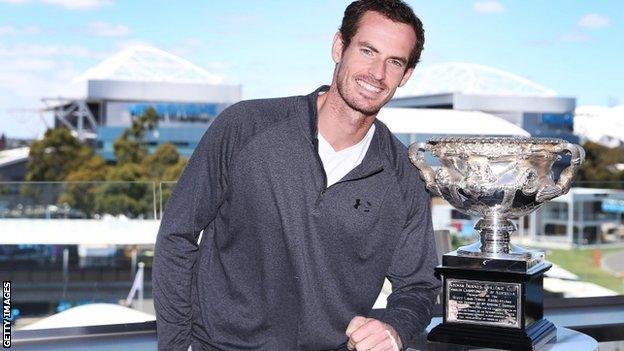Andy Murray's expectations 'tempered' before Australian Open
- Published

Andy Murray captioned this picture "the closest I'll ever get to the Aussie Open trophy #5timeloser"
Australian Open 2019 |
|---|
Venue: Melbourne Park Dates: 14-27 January |
Coverage: Daily live commentaries on the BBC Sport website, listen to Tennis Breakfast daily from 07:00 GMT on BBC Radio 5 live sports extra and watch highlights on BBC TV and online from 19 January. |
A year on from hip surgery, and with just eight wins to show for his trouble, Andy Murray has definitely not lost his sense of humour.
On New Year's Eve, he posted a picture of himself drinking from an (empty?) bottle of champagne. Six other unopened bottles of booze were in front of the teetotaller as he "celebrated" the end of a miserable 2018.
And then again on Instagram a week later, Murray could be seen perched next to the Australian Open trophy with the self-deprecating admission that, as a five-time runner-up, it is the closest he is ever likely to get.
The Scot's humour remains undimmed, but his expectations have been tempered.
His language has changed noticeably at the start of this new year in the run-up to next week's Australian Open.
In the immediate aftermath of last January's surgery in Melbourne, Murray declared himself "very optimistic" about the future. He felt he would be able to compete once again at the highest level: his aim was to win major events.
And then five months later, before making his return to the tour at The Queen's Club, Murray said his doctors had told him there was absolutely no reason why he could not be competitive again.
But at last week's Brisbane International, where he lost in the second round, Murray was far more measured.
There are still things he wishes to achieve, he said, but "whether I'm capable of that, I don't really know".
He wants to be able to enjoy the game for as long as possible, but admits he cannot be at all sure how far his right hip will carry him.

It is a year to the day since Murray posted this picture from his hospital bed after surgery
His surgeon, Dr John O'Donnell, went further in a remarkably frank interview on BBC Radio 5 Live's Sportsweek programme at the end of last month.
"Andy's hip is an ongoing problem," he said. "Not as bad as it was, but not normal."
"It had reached a point where he couldn't play. It wasn't really at a stage where we could attempt to make his hip normal, it was just to try and make it as much better as we could.
"He's certainly improved but he still has ongoing problems with it. I think he's been walking a tightrope for some time. It's just his intense desire to do well that's kept him going as well as he has."
No-one could possibly have done more.
In Cincinnati last August, in the run-up to the US Open, Murray was doing four hours of pool-based rehab a day - as well as spending up to three hours on the treatment table.
And then after calling time on his season at the end of September, the former world number one spent weeks in Philadelphia with Bill Knowles, who has also helped many Premier League footballers and Olympians with reconditioning after injury.
The idea was to "restore his athletic norm" - to try to get Murray's body ready again for the movement required on a tennis court. If that was best achieved by perfecting a cartwheel or a handstand, then so be it.
Why is Andy Murray doing cartwheels?
But for all his considerable effort, Murray arrives on the starting line in Melbourne at a distinct disadvantage. He is sporting a refurbished hip which has too many miles on the clock.
He remains in pain, both after matches and some training sessions. His lateral movement has suffered, especially out wide to the forehand. And those who have seen him get out of a car say he looks quite a bit older than his 31 years.
When you talk to former players about what Murray might still be able to achieve, the name of Lleyton Hewitt often crops up. They share a tenacity, a determination and a love of the sport, as well as the experience of major surgery.
Hewitt had left hip surgery at the age of 27, and an operation on his right hip two years later. The two-time Grand Slam champion and former world number one always maintains these surgeries were relatively minor: his big operation came just before his 31st birthday, when he had screws and a metal plate inserted into the big toe of his left foot.
Watch: Murray plays Djokovic in Australian Open practice
Hewitt won 26 of his 30 titles before the first hip surgery, and only two after the foot operation. They were the relatively minor ATP events on the hard courts of Brisbane and the grass courts of Newport, Rhode Island, in 2014. His highest ranking post foot surgery was 38 in the world.
And yet a month shy of his 38th birthday, Australia's Davis Cup captain plays on. He featured in the doubles in Brisbane last week, and in Sydney this week.
Murray seems more likely to be Davis Cup captain than Tour player at the same age, but that is for the future.
Let's live in the present - and enjoy him while we can.